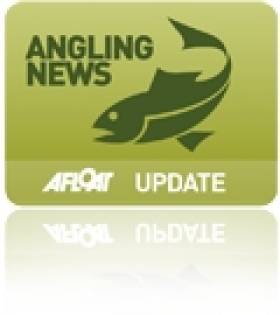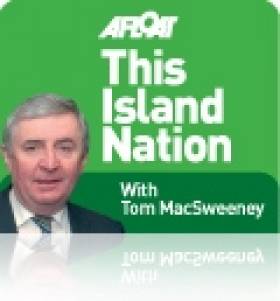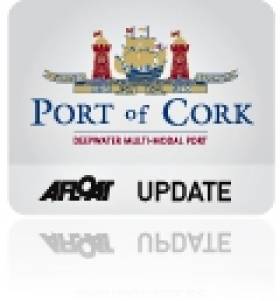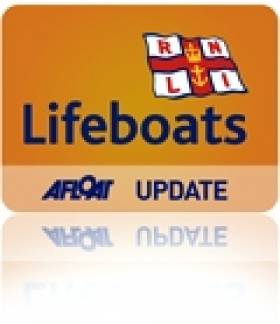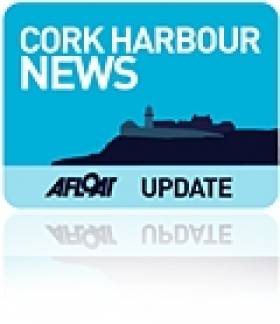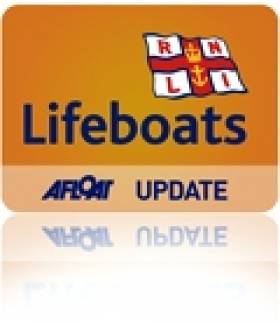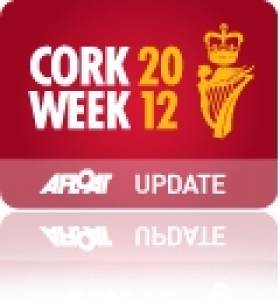Displaying items by tag: Cork Harbour
Cork Harbour Open Weekend Events Announced
#CORK HARBOUR - Due to the success of previous years’ festivals, Cork Harbour Open Day has now been expanded to a two-day Open Weekend for 2012, with activities for all ages taking place on Saturday 15 and Sunday 16 September.
The open weekend is a great opportunity for people to see exactly what Cork Harbour has to offer, and this year is no exception with the second largest natural harbour in the world playing host to the annual Cobh-to-Blackrock sailing race, kayaking on the River Lee and crab fishing in Cobh, while in Cork city the Naval Service vessel LE Ciara will be open to the public for free tours on both the Saturday and Sunday.
Visitors to Ringaskiddy over the weekend will be given the opportunity to go on a free guided tour around the National Maritime College of Ireland (NMCI) and see its panoramic bridge ship simulators, the survival pool and the marine workshops.
Also running in the NMCI will be free screenings of finalist entries of 8 Minutes: The Ford Short Film Competition. Part of the Titanic 100 event, the competition saw hundreds of entries from film-makers across Ireland who submitted short films of eight minutes in length based on a Titanic theme. All 12 finalists’ entries will be screened over the weekend.
To celebrate Cork Harbour Open Weekend, Spike Island is offering a family day out on the Island with live music, children’s entertainers and an opportunity to walk on the recently completed walking trail around the perimeter of Fort Mitchell with stunning views of Cork Harbour. Military exhibitions will also be on display. Visitors to the island are being encouraged to bring their own picnic. Guided Walking Tours of Fort Mitchell are also available at a 50% discount of the normal rate over the weekend. Boat rides will operate from Kennedy Pier in Cobh to the Island.
In Crosshaven, Camden Fort Meagher will be hosting military re-enactments on both days. On Sunday a family day will be held featuring children’s entertainers, a fancy dress competition and live music.
In Cobh, there will be crab fishing at the promenade from 3pm–5pm on the Saturday while Sunday will see a ‘Life Along the Seashore’ walk at 3pm. Also in Cobh on both Saturday and Sunday will be the ‘Great Island, Great Harbour, Great Ships, Great Puzzle’ treasure hunt.
Blackrock Castle Observatory will present its theatrical tours on Saturday and Sunday, bringing the colourful story of the castle to life from 400 years ago to present day. It’s a great venue for all the family and a superb location to watch the Cobh-to-Blackrock sailing race as the yachts head up the river.
Also taking place on the Saturday is the Emergency, Voluntary and Statutory Services Exhibition which will see demonstrations and drills showcasing the best of the emergency services. Organisers will simulate crash scenes, perform fire-fighting displays, take to the River Lee in sea riders to perform RIB displays and mount a simulated rescue operation in which rescue personnel will abseil from buildings.
Aimed at embracing all that Cork Harbour has to offer, the Cork Harbour Open Weekend aims to raise awareness of the different activities available for people in the harbour both on and off the water. It’s a great day for all the family with many events free to everyone.
The idea for a Harbour Open Day, now extended to a full weekend, emerged from discussions between various stakeholders involved in the development and implementation of the Integrated Strategy for the Harbour in 2007. This has been taken forward by the Harbour Management Focus Group (HMFG) which meets quarterly to exchange information on Harbour issues. The HMFG working group comprising representatives from UCC, City and County Councils and the Port of Cork set about working together to engage users of the Harbour and to organise the Open Day.
For more information on Cork Harbour Open Weekend and to view the full programme of events visit www.corkharbour.ie.
Shark 'Attack' of a Different Kind in Cork Harbour
#ANGLING - Known as the 'wolves of the sea', blue sharks haven't yet been showing in numbers off Cork Harbour, but a number of them surprised a group of anglers recently.
Donie Geary of the angling boat John Boy tells Cork Harbour Angling Hub that he was taking out a group of UK anglers in an area north of the Ling Rocks in a calm Saturday morning.
The boat put out a shark trace using mackerel, bran and fish oil as bait, but as Geary says, he wasn't optimistic about their chances, especially with the low numbers of mackerel.
Meanwhile, the group enjoyed a morning and afternoon of bountiful bottom fishing, forgetting about the shark rods, when "one of the ratchets screamed off".
That one was a false start, Geary explains, but the next one was hooked - and after "about 30 minutes of gentle coaxing on 30lb braid" they landed an impressive 60lb blue.
A few more scraps with the marine predators later and an even bigger 80lb specimen was landed and photographed before release.
Here's hoping this 'shark attack' is a good omen for more blues in Cork coastal waters this year.
Cork Harbour Angling Hub has more on the story HERE.
Rambler Crew Thankful, A Story of Two Vessels, Our Paralympians and Cork's New Pilot Boat
The Rambler Crew thank Valentia Radio for saving their lives in the Fastnet Race, but Coast Guard management wants to shut the station .... My story of two vessels ... John Twomey's Parlaympian achievements ... Cork gets a new Pilot Boat and ... trying to make ship-boarding pilot ladders safer ... There's a lot about boats in this week's TIN ..... Read on ....
SAVING LIVES MATTERS MOST – NOT FINANCIAL CUTBACKS
August 15 this year marked a very special day for the crew of the yacht Rambler 100 – they were still alive and they celebrated that fact – and they sent from New York an Email to the staff of Valentia Radio Coastal Station in Kerry. Coast Guard management in Dublin has a proposal to shut down the station and transfer its work to Dublin, to the constituency of the Minister for Transport, as a support station to the main Dublin base!
On August 15 the Rambler 100 crew Emailed to the staff at Valentia Island Maritime Radio Station:
"Today marks the one-year anniversary of our unfortunate accident during the Fastnet Race. Each Rambler crew member has his own story of what happened during this time of distress, however, the one thing that we share is the gratitude we feel for the Valentia Island Coast Guard. The professionalism of the Valentia crew and the diligence in alerting all authorities for our successful rescue is the reason we are here to share in the celebration of survival today. Tonight at 5.42 p.m. New York time the Rambler team will gather together and raise our glass to the sea and send out our thanks to our new friends in Ireland. Gratefully yours, Wendy, George and the Rambler 100 Crew."
Not much more needs to be said about the importance of Valentia Island Coastal Radio Station and its continued operation. It has a long history of saving life at sea in addition to its other operations.
I have asked for an interview with the Director of the Coast Guard Chris Reynolds, to find out exactly what is going on with the management proposals and why they want to centralise operations in Dublin. One proposal is that a support base to the national centre in Dublin should be located Blanchardstown, which just happens to be in the constituency of Minister for Transport Leo Varadakar who will have the final decision to make on the future of the coastal radio stations at Valentia and Malin and who has already indicated that "tough" decisions will be taken.
Again, the question has to be raised, as it was when then Minister Dempsey sought to close Waterford SAR rescue station – How much is a life worth?
TWO BOATS – TWO STORIES
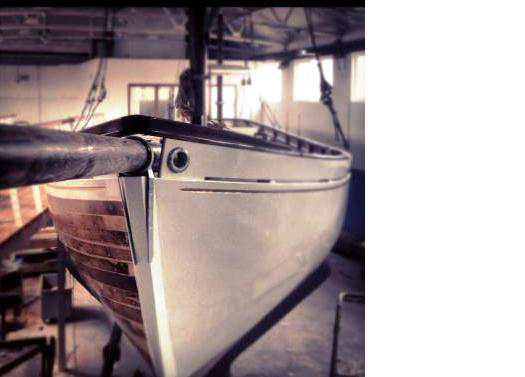
Asgard I pictured above, Celtic Mist in main image
Two boats, part of the Irish maritime scene in years past, are back in public – Asgard 1 and Celtic Mist – one ashore, the other afloat.
I was in the National Museum at Collins Barracks in Dublin when the historic ketch of Erskine and Mollie Childers went on exhibition after a five-year restoration project. It will be a permanent reminder of how the marine sphere was central to the formation of this Republic. Asgard looks superb. There was a lot of controversy over whether she should be restored or put to sea again, but the right decision has been made to conserve her ashore. The exhibition is open free-of-charge and worth seeing.
The second vessel, Celtic Mist, is the motor-sailing ketch of Charlie Haughey which his family donated to the Irish Whale and Dolphin Group. I was asked to re-dedicate it to its new role as a research vessel and did so on Sunday at Kilrush Marina, where hundreds watched the ceremony. I talked to Conor Haughey who told me: "They have rejuvenated her. She was getting old and tired and it would have been a shame if she rotted away rather than going to sea again. The boat was very important to my father. It has great family memories."
Onboard, Charles Haughey's cabin has been dismantled, including the bath and double berth and several bunks built instead for researchers who will track whales and dolphins and carry out other maritime research. Much of the eight-month refurbishment work was done by IWDG volunteers, with some contractors and financial assistance from the Clare Leader organisation and other supporters.
Despite all the controversy surrounding Haughey, as IWDG Director Simon Berrow said, getting the boat was a major benefit and came in the 21st year of its existence. In government Haughey had declared Ireland's waters a whale and dolphin sanctuary and Dr.Berrow said this should be followed by a
similar "pan-European designation" of EU waters. The Celtic Mist will provide a platform for finding out more about whales and other marine life off Ireland, he said.
JOHN TWOMEY AND THE IRISH PARALYMPIAN SAILORS

Irish Sonar Team
Kinsale Yacht Club member John Twomey is leading his crew into his tenth consecutive Paralympics, a magnificent achievement for the 57-year-old sailor. He will Skipper the Sonar, Ireland's only sailing entry, with crew Anthony Hegarty and Ian Costelloe. Sailing will be in the testing waters of Weymouth Bay on the south coast of England where the Olympic events were also held.
For the past three and a half decades he has been one of Ireland's most consistent and successful performers at the Paralympic Games. John is already the holder of Paralympic medals, won prior to his sailing career in the discus event - bronze in 1984 and gold at Seoul 1988. He also competed in table tennis before his transition to sailing, winning silver in the team event at Arnhem in 1980. Before moving to the three-man Sonar keelboat he sailed with Amy Kelleher in the mixed SKUD18 event at Beijing 2008, finishing tenth with a score of 75 points.
In preparing for this year's Paralympic John, Anthony and Ian were 7th in the World Disabled Sailing Championships in Florida and have been practising intensively off Kinsale over the past few weeks.
I met him at Kinsale YC and he was hopeful about their prospects:
"Tough waters in Weymouth, but with the experience of the past few months, particularly in the world championships we are well prepared."
John is from Ballinhassig, has represented Ireland more times than any other Olympic or Paralympic athlete. He is involved in sailing courses in Kinsale for people with disabilities where up to 30 sailors with a wide range of physical, intellectual and sensory disabilities go sailing every Saturday.
In Paralympic Sailing, three medal events feature one, two and three sailors per boat, respectively. All events consist of nine separate races with one point for first, two for second and so on, the same as in Olympic sailing. The winner has the lowest points total at the end of the nine races.
John's crew mates are 42-year-old Anthony from Mallow and 24-year-old Ian from Killorglin in County Kerry. Both are both amputees. John introduced Anthony to sailing seven years ago. He works as a software developer for Core International and has represented Ireland on several occasions. He is also a member of Kinsale Yacht Club.
Ian also sails out of Kinsale YC and will be making his first appearance at the Paralympic Games.
Paralympics Ireland CEO and Chef de Mission for the Irish Team, Liam Harbison, said there has been tremendous preparation, co-ordination and management of the Irish Team. "It's time for us to make a return on the faith and investment placed in us – we aim to deliver."

From left: John Twomey, Ian Costelloe and Anthony Hegarty.
NEW PILOT BOAT IN CORK
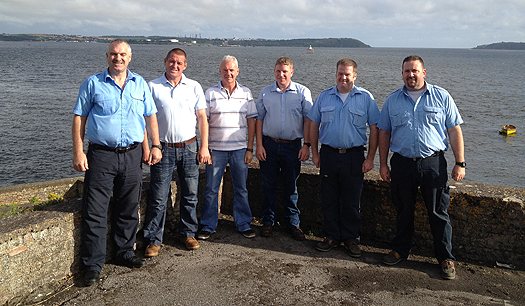
Cork Pilot Boat Crew
Cork Port has a new pilot boat. 'Failte' was built by Safehaven Marine and replaces 'Sonia' which has been in service for 14 years. Safehaven Marine is a Cork -based company, employing 25 staff in Little Island and Youghal. Since the company was founded in 1998. They have supplied pilot boats to countries from Scandinavia to the Middle East and are one of Europe's leading manufacturers of GRP pilot boat.
There are eight full-time crew, six of them pictured here – L to R: Ron Randalls, Carl Randalls, Gerry Moran, George Norris, Con Crowley and Keith Ryan. (Two were on holiday when the photo was taken.) The boat is an Interceptor 48 with two Volvo D13 engines, 600 hp each.
Cork pilot boats undertake in excess of 3,000 services per annum to vessels of all types including cruise ships and cargo vessels, according to the port company.
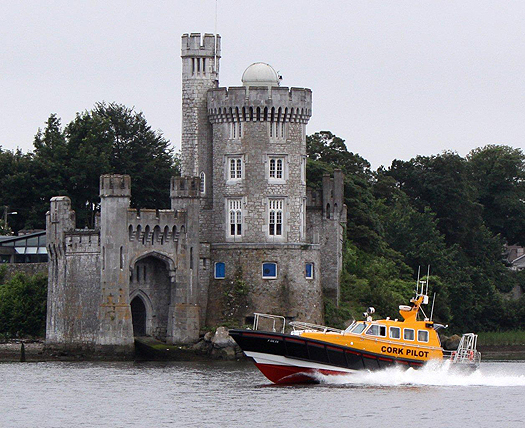
MAKING PILOTING SAFER
The International Maritime Pilots' Association and the International Chamber of Shipping have joined forces to update a brochure aimed at shipping companies and seafarers to ensure that ladders used for pilot transfers are safe and always rigged correctly.
The revised brochure – 'Shipping Industry Guidance on Pilot Transfer Arrangements' – is supported by a wide range of other international shipping bodies. It takes account of the latest amendments to the Safety of Life at Sea Convention (SOLAS) concerning pilot ladders, which came into effect on 1 July 2012.
IMPA Secretary General, Nick Cutmore, said: "Pilots continue to lose their lives as a result of accidents while boarding or disembarking from ships, and many more have been seriously injured."
ICS Secretary General, Peter Hinchliffe, added: "Some common causes of accidents still appear to be defects in the structure of the ladder treads or ropes, or a lack of a proper securing of the ladder to the ship."
An electronic copy of the IMPA/ICS brochure can be downloaded from the IMPA and ICS websites.
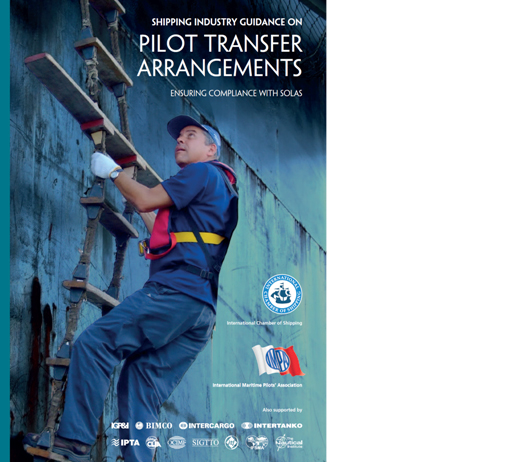
New Pilot Boarding Advice
--------------------------------------------------------------------------------------------------------
Email your comments on items in TIN develop maritime discussion to: [email protected]
Follow me for more maritime news and comment on Twitter: @TomMacSweeney
And on Facebook – THIS ISLAND NATION page
New Pilot Boat 'Failte' Gets a Big Cork Harbour Welcome
#corkharbour – Failte is the appropriate name for the first Irish boat most foreign ships and cruise liners will meet when they enter Cork harbour. The Port of Cork today officially named a new pilot boat at the Port of Cork City Marina. Built by Safehaven Marine, "Failte" will be replacing the "Sonia" which was named after Sonia O'Sullivan and has served the Port gallantly for the past fourteen years.
Dermot O'Mahoney, Chairman of the Port of Cork said "An Irish welcome is synonymous with the Port of Cork and reflects our attitude to all vessels that call to our harbour so it is fitting that we are christening our new pilot boat "Failte" today".
Captain Pat Farnan, Harbour Master and Deputy Chief Executive of the Port of Cork continued "Our pilots and launch crew provide a service that is second to none. Their skill and seamanship has seen some of the world's largest vessels such as the "Queen Mary 2" and the "Independence of the Seas" navigated safely in and out of our Port and I have no doubt "Failte" will serve the Port well for many years to come. The launches are required to operate in all weather conditions, 365 days a year and must be built to a very high standard to make this possible."
Safehaven Marine is a local Cork based company, employing 25 staff in Little Island and Youghal. Since the company was founded in 2008, they have supplied pilot boats to countries across the globe from Scandinavia to the Middle East and are now one of Europe's leading manufacturers of GRP pilot boat.
Safehaven Marine, Managing Director Frank Kowalski commented "We are delighted to once again be supplying the Port of Cork's new pilot vessel, "Failte" having also built their last new pilot boat, the "Gleann Mór" six years ago. It is extra special for us to be working with our local Port in delivering this vessel, which is a proud example of our high level design and engineering."
The pilot launches undertake in excess of 3,000 services per annum to vessels of all types including cruise ships and cargo vessels.
#rnil – A French yacht with a fouled propelller on passage to Kinsale in foggy conditions has been towed safely to Crosshaven in Co. Cork by the RNLI. At 7.20pm last night, Valentia Coast Guard tasked Crosshaven RNLI lifeboat to assist a 12m yacht with two people on board, 2 miles south of Power Head that had a fouled propellor. Weather conditions at the time were calm with heavy fog banks rolling off the coast.
Roberts Head is midway between the mouth of Cork Harbour and Kinsale the French registered yacht was on passage to Kinsale when they became entangled in an old lobster pot line and were effectively anchored. Crosshaven Lifeboat under the command of Ian Venner with crew Ritchie Kelleher and Vincent Fleming cut away the line and took the yacht in tow, arriving back in Crosshaven some 2 hours later.
The yacht was safely berthed at the Boatyard.
Cathedral Abseiling Challenge to Support Cobh People's Regatta
#COBH REGATTA - A parish priest is set to join a group of Cobh residents who will abseil from the turrets of the town's cathedral in an effort to save the Cobh People's Regatta.
According to the Irish Examiner, the fundraising challenge aims to support the annual regatta, which will run this year from 17-19 August.
"There are so many worthy causes out there, we needed something unique and this is it," said organiser Kathleen Geary. "I looked for an iconic building in Cobh for the abseil and the cathedral fitted the bill."
Fr Michael Leamy not only gave permission for the group to use the cathedral for the event this Saturday 4 August, but also signed up himself and is training hard with his 14 fellow abseilers at Ardmore Adventures.
Last year's regatta enjoyed plenty of wind and sunshine for the boats taking part, as reported on Afloat.ie.
Crosshaven Lifeboat Assists Youths Cut off by Tide
#rnli – Two young teenagers were rescued last night by the Crosshaven RNLI lifeboat after being cut off by the tide at Fort Camden. The two boys tried to make their way to safety across the rocks as the tide came in and wisely retreated back to the safety of Camden pier when they realized they were putting themselves in danger. The boys contacted the Coast Guard at Valentia who requested the volunteer crew to launch Crosshaven lifeboat at 10.15pm, to assist. The two youths were brought back to the lifeboat station at Crosshaven and required no further assistance.
#corkweek2012 – Last night's Upbeat Opening to Cork Week 2012 took place in a mood of palpable optimism and with the expectancy of a wonderful week ahead writes Claire Bateman. SCROLL DOWN THE PAGE FOR MORE PHOTOS! The buoyant mood had been set and the expectancy raised to even greater heights by the huge success of the Saturday and Sunday All Aboard @ Cork Week open days at the Royal Cork Yacht Club that far exceeded all expectations and resulted in the club being visited by over a thousand members of the public over the two days. It was a phenomenal experience for all involved and great credit must go to all concerned and in particular to the Cork Week Chairman, Pat Lyons, who mustn't have slept for six months at least.
The Official Opening that nearly didn't happen, but that's a story for the end of this paragraph, was performed by one of our own members, the Minister for Agriculture, Food and the Marine, Simon Coveney, who received a rapturous welcome. The Minister did indeed deliver a splendid speech that was both uplifting and encouraging. He told us what it felt like to remember being in the club as a child of five years of age and never would have thought in his wildest dreams he would be coming back as Minister for the Marine. He referred to the importance of the loyal sponsors who have remained with the event and named them all, in particular he spoke of the importance of the support from Fáilte Ireland with the publicity garnered by the event. He told of the huge work put in by Pat Lyons, Cork Week Chairman and Admiral Peter Deasy, and was full of admiration for the effort put in by the staff and particular attention was paid to the volunteer input by the club members. He also thanked the efforts put in by the overseas visitors who had travelled to attend and the huge home support. The Minister was so enthused and obviously so much at home in his own club he was utterly relaxed and the enthusiastic audience responded with their applause. In fact, he was so relaxed he was about to leave the podium when he suddenly remembered he had come to open Cork Week and hadn't officially done so and returned again to the podium to loud cheers from the assembled throng as he declared the event officially open.
It was very pleasing to note the attendance of so many Royal Cork former Admirals at the Official Opening Amongst these were Bill Walsh, who sailed Coral in the first ever Cork week in 1978, Tony O'Connor, Paddy McGlade, Anthony O'Leary, Bill O'Mahony and last but certainly not least former Admiral T.E. Crosbie, who, while we were waiting for the Official Opening to take place, regaled your scribe in his own inimitable style with wonderful tales going back to 1938 when the club was the Royal Munster Yacht Club. Now in his eighty second year former Admiral Crosbie will tomorrow (Monday) compete in Cork Week helming his well known 'No Excuse'.
So on that note I return to Cork Week 2012 and wish all competitors and officials an enjoyable week with safe sailing and great competition.
Royal Cork Lays on Big Welcome for Cork Week 2012
#corkweek – Royal Cork Yacht Club is bracing itself for the arrival of well over a thousand competitors in the next few days and over the past few weeks, local sailors have been working hard preparing their yachts moored in the safe confines of the marina. A steady stream of yachts from overseas has begun to arrive in Crosshaven to get ready for the big event, with many more expected to over the coming days.
Whilst the courses for Cork Week remain in the same likeable format, Cork Week Racing Chairman, Anthony O'Leary has revealed that there are some enterprising changes to the Harbour Course Race. "For the last day of racing, we intend to have the whole fleet in Cork Harbour, which should be a fantastic spectacle," commented O'Leary. "The Race Committee has also decided to award a long standing and very prestigious trophy at this year's event. The Carroll Cup dates back to 1858 and this year it will be the prize for a Harbour Race Time Trial. The Moonduster Mark – Cobh Mark –No.18 buoy section is a distance of 1.8nm and it is our intention to time each boat in the Harbour Race over this distance and apply their IRC handicap, to find the winner of the Carroll Cup 2012. The particular part of the course passes an area known as The Holy Ground and is featured in song and verse and is very much part of the folklore of Cork Harbour."
The Royal Cork is the oldest yacht club in the world and a glittering array of silverware will be awarded at Cork Week. In addition, for 2012 all class winners will also go home with a fine keepsake. The Belleek Group has been making fine china in Ireland for well over a century and overall class winners will receive a Belleek Living Trophy as a memento of their success.
Over one hundred yachts will be competing at Cork Week and the fun-factor looks like it could be at an all time high. Dermot Cronin from the Malahide Yacht Club will be racing his First 40.7, Encore and this is not the first venture to Cork Week for Dermot and his crew, as he explains; "We enjoyed 2010 so much, even though we suffered a badly cracked mast with my old J/35. We did a pub-crawl to 'wake' our lost mast and loved the barbecued cod and black pudding served up by the local pubs. We'll definitely be setting out in search of that this year. I particularly like a smaller regatta at Cork. After top class racing on the water, shoreside has a more laid back feel than past years. In the days of 600+ boats, getting to the bar was like wrestling through rush hour on the London underground!"
The ½ tonner "Insatiable" was built in 1985 and beautifully restored with the help of the Pendennis Shipyard in Falmouth. The crew are all friends from Cornwall and include a National and European Laser 4000 champion, Jon Wilson. Skipper Tim Cunliffe explains why the team have decided to bring "Insatiable" to Cork Week for the first time. "Most of the crew have been to Cork Week before and what makes us come back is good racing and on shore entertainment, some provided by our own crew! All of us have sailed to a very high level and we see Cork Week as a major regatta that we hope to do well in and hopefully win.
From the Clyde, Christine and Robin Murray's First 40, "Elf Too" will be competing at Cork Week, "Elf Too" arrived safely in Crosshaven on the 24th June and Christine is really looking forward to Cork Week. "This is the fourth time, I have come for the regatta and I just love it, Crosshaven is where my husband and I confessed our undying love for each other. The racing is so well managed and we all just have such a great laugh. We are also looking for a crewmember for Cork Week to cover for maternity leave for our pit-girl, if you apply you will definitely need a sense of humour." For more information visit: www.corkweek.ie
#CORK HARBOUR NEWS - Two anchors were recovered recently from the wreck of the historic Easter Rising gun running vessel in Cork Harbour, as The Irish Times reports.
Divers led by Eoin McGarry from Dungarvan and archaeologist Laurence Dunne from Tralee retrieved the anchors from the wreck of the Aud some 36 metres below the surface on Tuesday 19 June, in an operation that was two years in the planning.
The Aud was carrying 20,000 rifles and millions of rounds of ammunition in a shipment from the German military, arranged by Roger Casement, when the British navy uncovered the plan and took the vessel as it approached Tralee Bay.
But the vessel was scuttled by its Captain Karl Spindler as the ship was being taken to Cork Harbour. The wreck has rested at the bottom of the harbour near Daunt's Rock ever since.
The Department of Arts, Heritage and the Gaeltacht says the anchors will be undergoing conservation work over the next three years and will eventually be displayed in various locations provided by Cobh Town Council and Tralee and Fenit Harbour Commissioners.
RTÉ News has video footage of the dive team's discoveries, while The Irish Times has more on the story HERE.



























